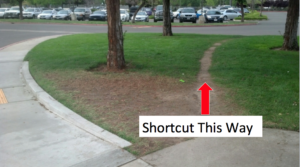Factoring Special Cases
Learning Objectives
- Special Cases - Squares
- Factor a polynomial of the form: [latex]{a}^{2}+2ab+{b}^{2}[/latex]
- Factor a polynomial of the form: [latex]{a}^{2}-{b}^{2}[/latex]
- Special Cases - Cubes
- Factor the sum of cubes.
- Factor the difference of cubes
Why learn how to factor special cases?
 Some people like to find patterns in the world around them, like a game. There are some polynomials that, when factored, follow a specific pattern.
Some people like to find patterns in the world around them, like a game. There are some polynomials that, when factored, follow a specific pattern.
These include:
Perfect square trinomials of the form: [latex]{a}^{2}+2ab+{b}^{2}[/latex]
A difference of squares: [latex]{a}^{2}-{b}^{2}[/latex]
A sum of cubes: [latex]{a}^{3}+{b}^{3}[/latex]
A difference of cubes: [latex]{a}^{3}-{b}^{3}[/latex]
 Some people find it helpful to know when they can take a shortcut to avoid doing extra work. There are some polynomials that will always factor a certain way, and for those we offer a shortcut. Most people find it helpful to memorize the factored form of a perfect square trinomial or a difference of squares. The most important skill you will use in this section will be recognizing when you can use the shortcuts.
Some people find it helpful to know when they can take a shortcut to avoid doing extra work. There are some polynomials that will always factor a certain way, and for those we offer a shortcut. Most people find it helpful to memorize the factored form of a perfect square trinomial or a difference of squares. The most important skill you will use in this section will be recognizing when you can use the shortcuts.
Factoring a Perfect Square Trinomial
A perfect square trinomial is a trinomial that can be written as the square of a binomial. Recall that when a binomial is squared, the result is the square of the first term added to twice the product of the two terms and the square of the last term.A General Note: Perfect Square Trinomials
A perfect square trinomial can be written as the square of a binomial:Exercises
Factor [latex]25{x}^{2}+20x+4[/latex].Answer: First, notice that [latex]25{x}^{2}[/latex] and [latex]4[/latex] are perfect squares because [latex]25{x}^{2}={\left(5x\right)}^{2}[/latex] and [latex]4={2}^{2}[/latex]. This means that [latex]a=5x\text{ and }b=2[/latex] Next, check to see if the middle term is equal to [latex]2ab[/latex], which it is:
[latex]2ab = 2\left(5x\right)\left(2\right)=20x[/latex].
Therefore, the trinomial is a perfect square trinomial and can be written as [latex]{\left(a+b\right)}^{2}={\left(5x+2\right)}^{2}[/latex].Answer
[latex-display]25{x}^{2}+20x+4={\left(5x+2\right)}^{2}[/latex-display]Example
Factor [latex]49{x}^{2}-14x+1[/latex].Answer: First, notice that [latex]49{x}^{2}[/latex] and [latex]1[/latex] are perfect squares because [latex]49{x}^{2}={\left(7x\right)}^{2}[/latex] and [latex]1={1}^{2}[/latex]. This means that [latex]a=7x[/latex], we could say that [latex]b=1[/latex], but would that give a middle term of [latex]-14x[/latex]? We will need to choose [latex]b = -1[/latex] to get the results we want:
[latex]2ab = 2\left(7x\right)\left(-1\right)=-14x[/latex].
Therefore, the trinomial is a perfect square trinomial and can be written as [latex]{\left(a-b\right)}^{2}={\left(7x-1\right)}^{2}[/latex].Answer
[latex-display]49{x}^{2}-14x+1={\left(7x-1\right)}^{2}[/latex-display]Given a perfect square trinomial, factor it into the square of a binomial.
- Confirm that the first and last term are perfect squares.
- Confirm that the middle term is twice the product of [latex]ab[/latex].
- Write the factored form as [latex]{\left(a+b\right)}^{2}[/latex], or[latex]{\left(a-b\right)}^{2}[/latex].
Factoring a Difference of Squares
A difference of squares is a perfect square subtracted from a perfect square. Recall that a difference of squares can be rewritten as factors containing the same terms but opposite signs because the middle terms cancel each other out when the two factors are multiplied.A General Note: Differences of Squares
A difference of squares can be rewritten as two factors containing the same terms but opposite signs.Example
Factor [latex]9{x}^{2}-25[/latex].Answer: Notice that [latex]9{x}^{2}[/latex] and [latex]25[/latex] are perfect squares because [latex]9{x}^{2}={\left(3x\right)}^{2}[/latex] and [latex]25={5}^{2}[/latex]. This means that [latex]a=3x,\text{ and }b=5[/latex] The polynomial represents a difference of squares and can be rewritten as [latex]\left(3x+5\right)\left(3x - 5\right)[/latex]. Check that you are correct by multiplying. [latex-display]\left(3x+5\right)\left(3x - 5\right)=9x^2-15x+15x-25=9x^2-25[/latex-display]
Answer
[latex-display]9{x}^{2}-25=\left(3x+5\right)\left(3x - 5\right)[/latex-display]Example
Factor [latex]81{y}^{2}-144[/latex].Answer: Notice that [latex]81{y}^{2}[/latex] and [latex]144[/latex] are perfect squares because [latex]81{y}^{2}={\left(9x\right)}^{2}[/latex] and [latex]144={12}^{2}[/latex]. This means that [latex]a=9x,\text{ and }b=12[/latex] The polynomial represents a difference of squares and can be rewritten as [latex]\left(9x+12\right)\left(9x - 12\right)[/latex]. Check that you are correct by multiplying. [latex-display]\left(9x+12\right)\left(9x - 12\right)=81x^2-108x+108x-144=81x^2-144[/latex-display]
Answer
[latex-display]81{y}^{2}-144=\left(9x+12\right)\left(9x - 12\right)[/latex-display]How To: Given a difference of squares, factor it into binomials.
- Confirm that the first and last term are perfect squares.
- Write the factored form as [latex]\left(a+b\right)\left(a-b\right)[/latex].
Think About It
Is there a formula to factor the sum of squares, [latex]a^2+b^2[/latex], into a product of two binomials? Write down some ideas for how you would answer this in the box below before you look at the answer. [practice-area rows="1"][/practice-area]Answer: There is no way to factor a sum of squares into a product of two binomials, this is because of addition - the middle term needs to "disappear" and the only way to do that is with opposite signs. to get a positive result, you must multiply two numbers with the same signs. The only time a sum of squares can be factored is if they share any common factors, as in the following case: [latex-display]9x^2+36[/latex-display] [latex-display]9x^2={(3x)}^2, \text{ and }36 = 6^2[/latex-display] The only way to factor this expression is by pulling out the GCF which is 9. [latex-display]9x^2+36=9(x^2+4)[/latex-display]
Cubes
Some interesting patterns arise when you are working with cubed quantities within polynomials. Specifically, there are two more special cases to consider: [latex]a^{3}+b^{3}[/latex] and [latex]a^{3}-b^{3}[/latex]. Let’s take a look at how to factor sums and differences of cubes.Sum of Cubes
The term “cubed” is used to describe a number raised to the third power. In geometry, a cube is a six-sided shape with equal width, length, and height; since all these measures are equal, the volume of a cube with width x can be represented by [latex]x^{3}[/latex]. (Notice the exponent!) Cubed numbers get large very quickly. [latex]1^{3}=1[/latex], [latex]2^{3}=8[/latex], [latex]3^{3}=27[/latex], [latex]4^{3}=64[/latex], and [latex]5^{3}=125[/latex]. Before looking at factoring a sum of two cubes, let’s look at the possible factors. It turns out that [latex]a^{3}+b^{3}[/latex] can actually be factored as [latex]\left(a+b\right)\left(a^{2}–ab+b^{2}\right)[/latex]. Let’s check these factors by multiplying.Example
Does [latex](a+b)(a^{2}–ab+b^{2})=a^{3}+b^{3}[/latex]?Answer: Apply the distributive property.
[latex]\left(a\right)\left(a^{2}–ab+b^{2}\right)+\left(b\right)\left(a^{2}–ab+b^{2}\right)[/latex]
Multiply by a.[latex]\left(a^{3}–a^{2}b+ab^{2}\right)+\left(b\right)\left(a^{2}-ab+b^{2}\right)[/latex]
Multiply by b.[latex]\left(a^{3}–a^{2}b+ab^{2}\right)+\left(a^{2}b–ab^{2}+b^{3}\right)[/latex]
Rearrange terms in order to combine the like terms.[latex]a^{3}-a^{2}b+a^{2}b+ab^{2}-ab^{2}+b^{3}[/latex]
Simplify.Answer
[latex]a^{3}+b^{3}[/latex]
The Sum of Cubes
A binomial in the form [latex]a^{3}+b^{3}[/latex] can be factored as [latex]\left(a+b\right)\left(a^{2}–ab+b^{2}\right)[/latex].Examples:
The factored form of [latex]x^{3}+64[/latex] is [latex]\left(x+4\right)\left(x^{2}–4x+16\right)[/latex]. The factored form of [latex]8x^{3}+y^{3}[/latex] is [latex]\left(2x+y\right)\left(4x^{2}–2xy+y^{2}\right)[/latex].Example
Factor [latex]x^{3}+8y^{3}[/latex].Answer: Identify that this binomial fits the sum of cubes pattern: [latex]a^{3}+b^{3}[/latex]. [latex]a=x[/latex], and [latex]b=2y[/latex] (since [latex]2y\cdot2y\cdot2y=8y^{3}[/latex]).
[latex]x^{3}+8y^{3}[/latex]
Factor the binomial as [latex]\left(a+b\right)\left(a^{2}–ab+b^{2}\right)[/latex], substituting [latex]a=x[/latex] and [latex]b=2y[/latex] into the expression.[latex]\left(x+2y\right)\left(x^{2}-x\left(2y\right)+\left(2y\right)^{2}\right)[/latex]
Square [latex](2y)^{2}=4y^{2}[/latex].[latex]\left(x+2y\right)\left(x^{2}-x\left(2y\right)+4y^{2}\right)[/latex]
Multiply [latex]−x\left(2y\right)=−2xy[/latex] (writing the coefficient first).Answer
[latex]\left(x+2y\right)\left(x^{2}-2xy+4y^{2}\right)[/latex]
Example
Factor [latex]16m^{3}+54n^{3}[/latex].Answer: Factor out the common factor 2.
[latex]16m^{3}+54n^{3}[/latex]
[latex]8m^{3}[/latex] and [latex]27n^{3}[/latex] are cubes, so you can factor [latex]8m^{3}+27n^{3}[/latex] as the sum of two cubes: [latex]a=2m[/latex], and [latex]b=3n[/latex].[latex]2\left(8m^{3}+27^n{3}\right)[/latex]
Factor the binomial [latex]8m^{3}+27n^{3}[/latex] substituting [latex]a=2m[/latex] and [latex]b=3n[/latex] into the expression [latex]\left(a+b\right)\left(a^{2}-ab+b^{2}\right)[/latex].[latex]2\left(2m+3n\right)\left[\left(2m\right)^{2}-\left(2m\right)\left(3n\right)+\left(3n\right)^{2}\right][/latex]
Square: [latex](2m)^{2}=4m^{2}[/latex] and [latex](3n)^{2}=9n^{2}[/latex].[latex]2\left(2m+3n\right)\left[4m^{2}-\left(2m\right)\left(3n\right)+9n^{2}\right][/latex]
Multiply [latex]-\left(2m\right)\left(3n\right)=-6mn[/latex].Answer
[latex]2\left(2m+3n\right)\left(4m^{2}-6mn+9n^{2}\right)[/latex]
Difference of Cubes
Having seen how binomials in the form [latex]a^{3}+b^{3}[/latex] can be factored, it should not come as a surprise that binomials in the form [latex]a^{3}-b^{3}[/latex] can be factored in a similar way.The Difference of Cubes
A binomial in the form [latex]a^{3}–b^{3}[/latex] can be factored as [latex]\left(a-b\right)\left(a^{2}+ab+b^{2}\right)[/latex].Examples
The factored form of [latex]x^{3}–64[/latex] is [latex]\left(x–4\right)\left(x^{2}+4x+16\right)[/latex]. The factored form of [latex]27x^{3}–8y^{3}[/latex] is [latex]\left(3x–2y\left)\right(9x^{2}+6xy+4y^{2}\right)[/latex].Example
Factor [latex]8x^{3}–1,000[/latex].Answer: Factor out 8.
[latex]8(x^{3}–125)[/latex]
Identify that the binomial fits the pattern [latex]a^{3}-b^{3}:a=x[/latex], and [latex]b=5[/latex] (since [latex]5^{3}=125[/latex]).[latex]8\left(x^{3}–125\right)[/latex]
Factor [latex]x^{3}–125[/latex] as [latex]\left(a–b\right)\left(a^{2}+ab+b^{2}\right)[/latex], substituting [latex]a=x[/latex] and [latex]b=5[/latex] into the expression.[latex]8\left(x-5\right)\left[x^{2}+\left(x\right)\left(5\right)+5^{2}\right][/latex]
Square the first and last terms, and rewrite [latex]\left(x\right)\left(5\right)[/latex] as [latex]5x[/latex].[latex]8\left(x–5\right)\left(x^{2}+5x+25\right)[/latex]
Answer
[latex]8\left(x–5\right)\left(x^{2}+5x+25\right)[/latex]
Example
Factor [latex]r^{9}-8s^{6}[/latex].Answer: Identify this binomial as the difference of two cubes. As shown above, it is. Using the laws of exponents, rewrite [latex]r^{9}[/latex] as [latex]\left(r^{3}\right)^{3}[/latex].
[latex]r^{9}-8s^{6}[/latex]
Rewrite [latex]r^{9}[/latex] as [latex]\left(r^{3}\right)^{3}[/latex] and rewrite [latex]8s^{6}[/latex] as [latex]\left(2s^{2}\right)^{3}[/latex].[latex]\left(r^{3}\right)^{3}-\left(2s^{2}\right)^{3}[/latex]
Now the binomial is written in terms of cubed quantities. Thinking of [latex]a^{3}-b^{3}[/latex], [latex]a=r^{3}[/latex] and [latex]b=2s^{2}[/latex]. Factor the binomial as [latex]\left(a-b\right)\left(a^{2}+ab+b^{2}\right)[/latex], substituting [latex]a=r^{3}[/latex] and [latex]b=2s^{2}[/latex] into the expression.[latex]\left(r^{3}-2s^{2}\right)\left[\left(r^{3}\right)^{2}+\left(r^{3}\right)\left(2s^{2}\right)+\left(2s^{2}\right)^{2}\right][/latex]
Multiply and square the terms.[latex]\left(r^{3}-2s^{2}\right)\left(r^{6}+2r^{3}s^{2}+4s^{4}\right)[/latex]
Answer
[latex]\left(r^{3}-2s^{2}\right)\left(r^{6}+2r^{3}s^{2}+4s^{4}\right)[/latex]
- A binomial in the form [latex]a^{3}+b^{3}[/latex] can be factored as [latex]\left(a+b\right)\left(a^{2}–ab+b^{2}\right)[/latex]
- A binomial in the form [latex]a^{3}-b^{3}[/latex] can be factored as [latex]\left(a-b\right)\left(a^{2}+ab+b^{2}\right)[/latex]
Licenses & Attributions
CC licensed content, Original
- Screenshot: Method to the Madness. Provided by: Lumen Learning License: CC BY: Attribution.
- Image: Shortcut This Way. Provided by: Lumen Learning License: CC BY: Attribution.
- Revision and Adaptation. Provided by: Lumen Learning License: CC BY: Attribution.
CC licensed content, Shared previously
- Factor Perfect Square Trinomials Using a Formula. Authored by: James Sousa (Mathispower4u.com) for Lumen Learning. License: CC BY: Attribution.
- Ex: Factor a Difference of Squares. Authored by: James Sousa (Mathispower4u.com). License: CC BY: Attribution.
- Unit 12: Factoring, from Developmental Math: An Open Program. Provided by: Monterey Institute of Technology and Education Located at: https://www.nroc.org/. License: CC BY: Attribution.
- Authored by: James Sousa (Mathispower4u.com) for Lumen Learning. License: CC BY: Attribution.
- Ex 3: Factor a Sum or Difference of Cubes. Authored by: James Sousa (Mathispower4u.com) for Lumen Learning. License: CC BY: Attribution.
- Factor Expressions with Negative Exponents. Authored by: James Sousa (Mathispower4u.com) for Lumen Learning. License: CC BY: Attribution.
- Factor Expressions with Fractional Exponents. Authored by: James Sousa (Mathispower4u.com) for Lumen Learning. License: CC BY: Attribution.
- Factor Expressions Using Substitution. Authored by: James Sousa (Mathispower4u.com) for Lumen Learning. License: CC BY: Attribution.
- Ex: Factoring Polynomials with Common Factors. Authored by: James Sousa (Mathispower4u.com) for Lumen Learning. License: CC BY: Attribution.

